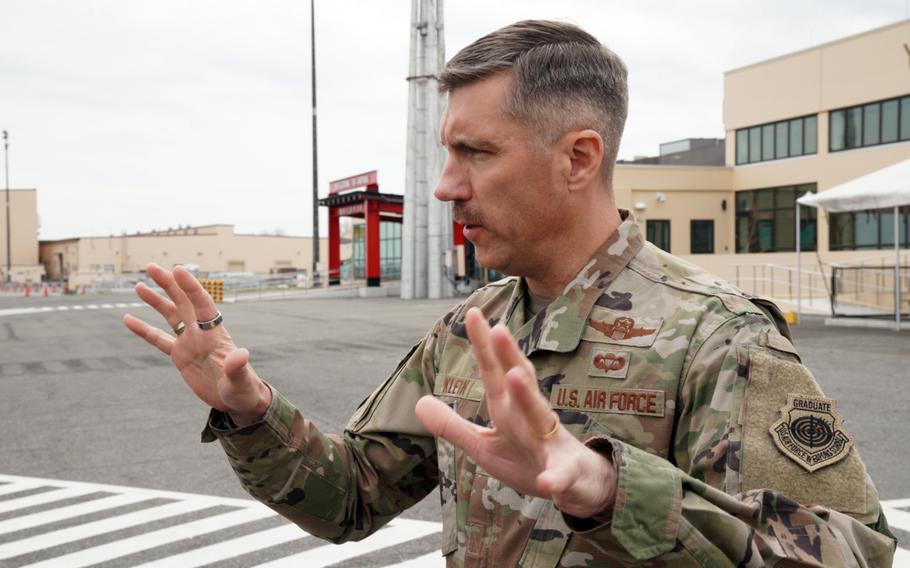
Maj. Gen. John Klein, commander of the Air Force Expeditionary Center, speaks to airmen at Yokota Air Base, Japan, Tuesday, March 21, 2023. (Akifumi Ishikawa/Stars and Stripes)
YOKOTA AIR BASE, Japan — The risk of war with China is spurring the U.S. Air Force to create “air mobility teams” charged with dispersing quickly to deliver cargo to far-flung spots across the Indo-Pacific.
Airmen at the home of U.S. Forces Japan in western Tokyo explained how the teams work during a Monday visit by Maj. Gen. John Klein, commander of the Air Force Expeditionary Center at Joint Base McGuire-Dix-Lakehurst, N.J.
“The U.S. Air Force is absolutely reorienting toward our pacing challenge of the People’s Republic of China,” Klein told Stars and Stripes before departing Yokota on Tuesday.
The installation — along with Kadena Air Base, Okinawa; Osan Air Base, South Korea; Andersen Air Force Base, Guam; and Joint Base Pearl Harbor-Hickam, Hawaii — serves as an air mobility hub that allows the United States to project power across the Indo-Pacific, he said.
Air mobility teams can disperse to other facilities —civilian airports, for example — to provide some of the same services available at the major hubs, Klein aid.
“The pacing challenge is going to drive a very rapid pace of conflict if we ever get to that stage,” he said.
The goal of an air mobility team is to provide cargo and passenger services in concert with aircraft and aircrew as fast and efficiently as possible, Klein said.
Four members of Yokota’s 730th Air Mobility Squadron formed a small team, including maintainers and cargo handlers, to support the deployment of MQ-9 Reaper drones to Kanoya Air Base in southern Japan late last year, the team’s leader, Master Sgt. Steven Bazar, told Klein on Monday.
Eight Reapers and more than 150 airmen in the newly formed 319th Expeditionary Reconnaissance Squadron began a yearlong deployment to Kanoya in October. The facility is a Japan Maritime Self-Defense Force base near the southern tip of Kyushu, the southernmost of Japan’s four main islands.
The air mobility team, along with a loading vehicle, flew from Yokota to Kanoya in a C-130J Super Hercules airlifter in late September, Bazar said.
Their first task involved working with Japanese sailors to measure taxiways to prepare for the arrival of C-17 Globemaster III aircraft transporting the drones from Creech Air Force Base, Nev., he said.
A C-17 landed at Kanoya two decades ago, but the aircraft didn’t return until they delivered the drones, he said.
The airmen came up with a plan to steer the C-17s away from a sinkhole detected by the Japanese near the runway, he said.
“Believe it or not, they have wild hogs out there.” Bazar said, adding that landing lights had to be protected from the pigs.
The team’s work included welcoming an advance party from Pacific Air Forces and receiving government vehicles brought to the base by road and air, he said.
Over the course of 40 days, the air mobility team helped unload 319 tons of cargo and 130 personnel from 11 C-17s, 11 C-130Js and five C-12J Huron passenger planes, Bazar said.